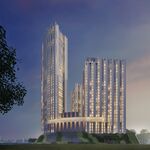Soooo, our own
@AlexBozikovic has a thread going over on Twitter, which I will link below, in which he expresses some exasperation with the City's Road Design guidelines (on that he is not wrong); in this case
in relation to a project to install one long block of new sidewalk, in front of a school, on Dwight Avenue in Etobicoke.
Twitter thread here:
From said thread:
This is the stretch of road in question:
The proposal is to remove this row of trees in order to add a sidewalk (a new of trees will be planted)
****
Alex posted this slide from the City Presentation, which I will also link below:
The full presentation can be found here:
**********
So, my thoughts:
1) The road design guideline, with a 5.6M drive lane here is nuts, I'm all for revising that guideline.
2) What Alex does not mention in his thread (that I noticed) was that the road is not being resurfaced or reconstructed, the sidewalk is a stand-alone project. As such, in the City's terms, the design guideline isn't all that relevant, in that they have no desire to open up the road to build the sidewalk. Its not a small matter, as the existing curbs and gutters (sewer grates) would need to be relocated as well, the necessitates open up the road and the road base, its a much more expensive project. I'm not arguing against that, per se.........but its important to consider that even if the road design were narrowed, the project would be vastly more expensive and not within the approved budget.
3) Now, that said, there are other things at play here............but let's consider the idea mentioned that the City is sparing the School Parking lot, by not placing the sidewalk to the inside of the trees. In fairness to Alex, this is the way the City addresses the idea of the sidewalk in that location in its presentation. But, that really isn't true.
This is an aerial view of the school/sidewalk site, I have highlighted the parking lot:
As you can see, its a very small portion of the area in question. If, for argument's sake, you didn't want to impinge on the parking lot (not that I have an issue w/this), its important to note that you would only remove two trees if you ran the sidewalk where the City proposed (instead of the whole row), while adjacent to the parking lot, before shifting it to the inside of the tree row (west) along the edge of the school field.
The City is frankly being misleading in suggesting that the parking lot is a material issue. Were they arguing about impinging on the playable area of the field that may/may not be fair.......but the parking lot is not that big a deal. It is important to note, however, that for the new sidewalk to be far enough to the west not to seriously damage the existing trees, it would have to be well into TDSB property. Its not clear to me from the City presentation if the TDSB was asked about this possibility or open to it.
***
Now lets make it more complicated still; several of the established trees are European Ash; are susceptible to the Emerald Ash Borer. Those trees are unlikely to survive beyond the next 10 years, irrespective of the sidewalk.
The largest number of the remaining trees are Norway Maple, a non-native, invasive tree. Though, to complicate things further, I wouldn't really champion removing the Norways here, if they are in good health; because the nearest sensitive environmental area is more than 1.4km away (Col. Sam Smith Park) the prevailing winds (for blowing seed) run the opposite direction.
***
But before anyone thinks I'm letting the City off the hook.................(which I'm not)...........this is just glaringly bad..........
The City has proposed 17 replacement trees; after going on about how the Norways and (European Ash) aren't native...........
Only 5/17 replacement trees are proposed to be native............. SMH (from the presentation linked above)
PS, Horse Chestnut is invasive........
*****
In the end, I share Alex's frustration at the guidelines, wouldn't mind sparing some of the trees in question, and would support narrowing the road; though I understand why the City doesn't want to put that on the table just at the moment.
But the fact that the City is less than clear on its reasoning.....(and we could talk about the fence related excuse separately, but I didn't want to drag out the post).....
On top of which they propose mostly non-native trees as replacements...............
Eeesh this City can be frustrating at times.
Safe biking infra is more important.
Safe biking infra is more important.







